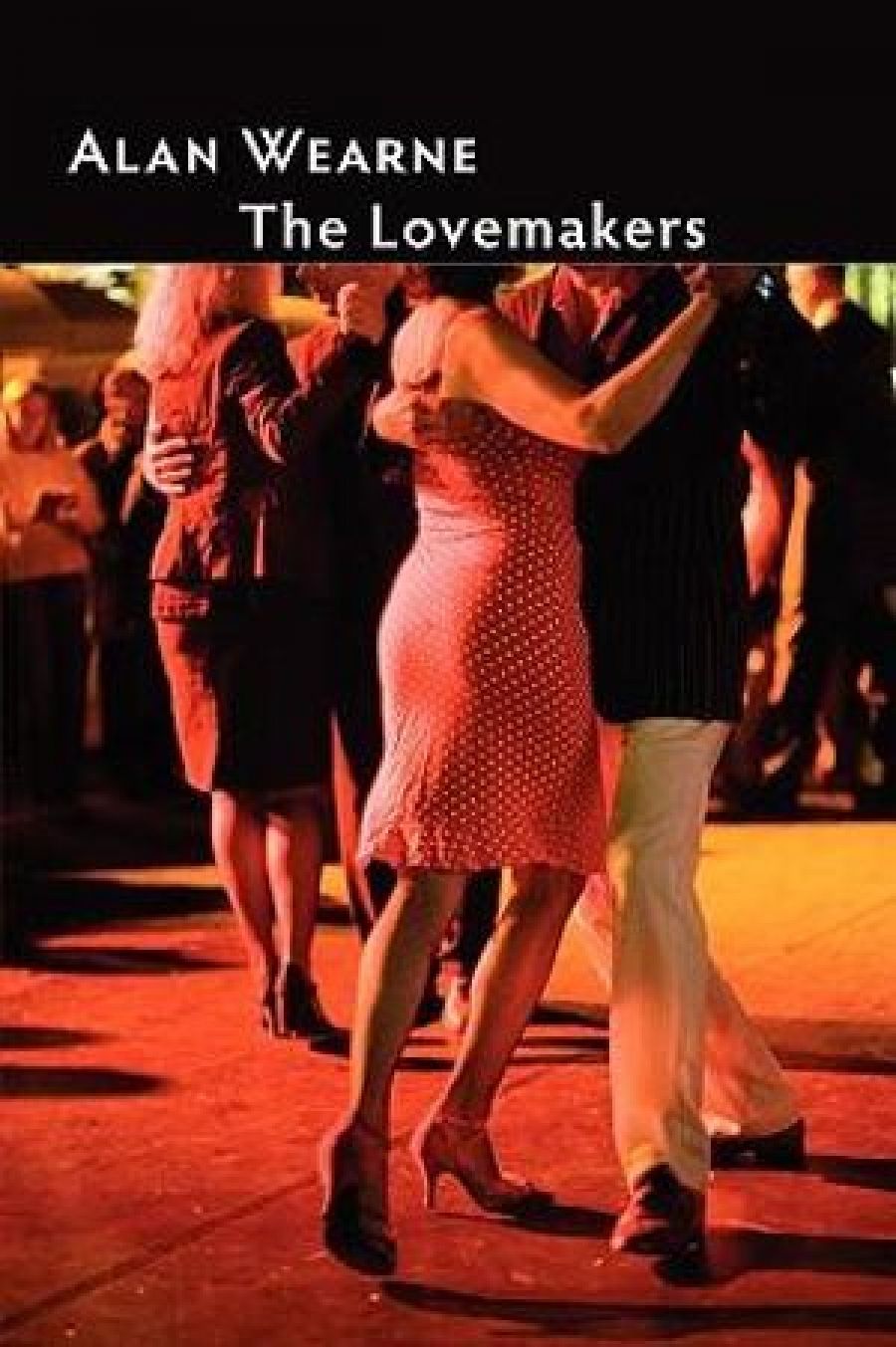
- Free Article: No
- Contents Category: Fiction
- Review Article: Yes
- Custom Highlight Text:
A Geelong psychiatrist once asked someone very like me, ‘What’s the opposite of love?’ It was a bit like a question in a tutorial (psychiatrists and academics do have a thing or two in common). The answer, of course, couldn’t be so obvious as ‘hate’. It was ‘indifference’.
- Book 1 Title: The Lovemakers
- Book 1 Biblio: Penguin $29.00 pb, 359 pp
- Book 1 Readings Link: booktopia.kh4ffx.net/Xzxm3
In the 1977 ‘New Writing’ issue of Australian Literary Studies, Wearne asked: ‘What the hell is going on? Yes, that is the question I find I ask myself. Not the goon-like neo-McKuen, oh-agony Who-am-I? Not the what-is-this-country? antics of the Blinky-Bill dickhead nationalists. Not the o-man-I-see-it-all tradition of the druggists – Dransfield and onwards.’ If this seems a bit dated, the question’s still relevant to Wearne's large-scale projects. ‘What the hell is going on?’ is likely to be asked by a reader coming cold to The Lovemakers. (It took me fifty pages to get the book’s groove.) And it is also the anxious question of a reviewer. Loose, baggy monsters like The Lovemakers leave first readers wondering if the work is actually highly organised. One can almost hear the author asking, ‘Didn't you notice that this is a rewriting of The Odyssey/The Tempest/Toy Story?’
The existence of a hidden template, an enigma machine to decode the text, is a beguiling idea, and one that the text toys with in its coincidences, echoes, intersections and motifs. But myth and archetype are unlikely to attract Wearne, given his interest in the quotidian, the quiddity of things, and the imperfect that is our paradise – that is, ‘what is going on’. Instead of the clay of myth, perhaps this is a roman à clef. Some characters suggest this, especially Toby, reminiscent of one of those drug-using poets, ‘terrifyingly close to genius’, who died in the early 1970s.
So what does go on in The Lovemakers? The work’s eight discontinuous (but interconnecting) narratives range from 1960 to the 1980s. As with Out Here, Wearne’s superb 1976 verse novella, and The Nightmarkets, many events are standard melodrama: love affairs, crimes, marriages, the secret dynamics of families. But, as with those earlier works, Wearne avoids melodramatic effects. Rather, voice and characterisation are paramount.
The work opens darkly with the criminal underclass, and the apparently unjust hanging of a man accused of murder. More familiar Wearne territory begins with ‘Catholics for Friends’, which concentrates upon a group of youths in 1960s Sydney, many of whom appear later. One of these characters appears in the work’s longest story, ‘Lovelife’, which covers the love triangle of Roger and Barb (who have an open marriage) and Neil. Neil and Barb engage in their own white-collar crime, mixing illegal business with illicit pleasure. Wearne characteristically highlights the relationship between risk and pleasure.
The work traces social changes, often through criminality, but the suburbia that Wearne detailed so masterfully in Out Here is also present. And the work’s scope also shows the intricate systems of Australian life. One of the demands and pleasures of the work is to recognise characters marginal in one section who suddenly become central in another. As the work dramatises, this isn’t only about connections – understanding who we are and so on – but also praise and blame. Regarding an unsuitable affair between a girl and an older (criminal) man we're told about life’s patterns: ‘anyone being connected with everyone: a near virus, /something most adults wish would never occur, /except it gives them someone to blame.’
What makes Wearne's books so readable and impressive (despite their often-bizarre dialogue and frustrating way with plot) is their contradictory quality: their ability to present life as poetry without letting the messy, undiluted quality of the former overcome the musical, formalised quality of the latter. This tension may be why one feels that, like God, Wearne is sometimes making it up as he goes along. The opening section remains opaque until the work’s end, and some narratives are more interesting than others. There are, as one might expect, longueurs. But The Lovemakers is, for me, more successful than The Nightmarkets, partly because it's shorter, partly because it's less reliant on monologue. There is greater variety in perspective and form. While Wearne used rhyme in the earlier work, here its use is more effective. There is a sonnet sequence, a funny limerick sequence, villanelles, and a satirical section in ottava rima. The mixture of satire and plangent realism is brilliantly executed throughout the work.
In terms of realism (if one can discuss such originality with such a blunt term), Wearne’s stories of love and work strangely lack anxiety and children. But Wearne illuminates things about our social and moral worlds that were once expected from the great novelists: that even good people can be opportunistic, for instance. What The Lovemakers illustrates beautifully is that life leaves traces in our memories and bodies that are both indelible and only partly legible. If we sometimes wonder what the hell is going on, there’s no harm in that. Roger, discussing his marriage with his psychiatrist, iterates the opening point about love and indifference. Confessing to his doctor (or himself) is ‘to tell, retell of love and its anger: the flame, how we fan it/to a blaze’. Wearne’s idiosyncratic style and strangely arranged verbal worlds show that one cannot be in love with anything – language, poetry, the world – and be indifferent to it.


Comments powered by CComment